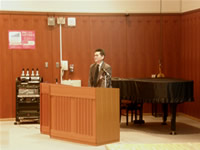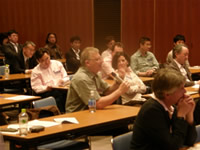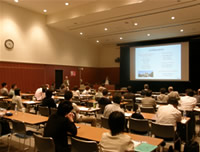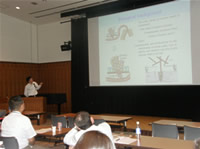




The Third CREST-SBM International Conference “Mathematical Methods in Cancer Cell Biology” was hosted by Dr. Takashi Suzuki (Graduate School of Engineering Science, Osaka University), Head Researcher of the research task "Mathematical Medicine Develops Tumor Growth Explications and Medical Technology Innovations " which is underway in the CREST research area "Alliance for Breakthrough between Mathematics and Sciences (ABMS)." The conference was held in the Koujin Conference Hall, Faculty of Medicine, Hiroshima University from June 8 (Wednesday) to June 9 (Thursday), 2011.
Dr. Suzuki's Team is carrying out collaborative research between mathematical science and medicine with tumorigenesis and its diagnosis as the theme. In recent years, this research area has been displaying signs of spreading internationally, for example there was a large project in the United States and Europe and integrated research between biology and mathematical science that has been developing and also there has been the establishment of new methods of mathematical modeling and mathematical analysis backed by advances in cell biology. This research conference invited five people from overseas (two Americans, one British, one German and one South Korean) who are active as leaders in mathematical cell biology research. The objective was to establish international cooperation from both the sides of administration and research through reports and discussion. Along with this, the aim was to widely disseminate to society the latest trends and project results to-date in mathematical cell biology research and to explore the way of making practical use of research.
The decision to hold the conference in Hiroshima was from the fact that it is a place that holds an extremely high level of interest for the researchers invited from overseas and because it is considered to be ideal as a place for information dissemination of newly produced project research as sacred ground in cancer research. Fortunately, joint sponsorship was possible with the Hiroshima Cancer Seminar Foundation and many participants, beyond expectations, who are engaged in areas such as mathematical science, clinical and basic medicine, medical care and business, were able to attend. The total number of participants was 87 (75 from Japan and 12 from overseas).
On the morning of the first day of this research conference, there was an introduction to the JST and CREST by Mr. Osamu Ichimaru, Senior Chief Researcher of the JST. Next, the Head Researcher Dr. Suzuki gave the keynote speech on mathematical medicine research to-date in the CREST. This was followed by Dr. Vito Quaranta, the overseas liaison research office representative (Vanderbilt University Medical Center, U.S.), and Dr. Motoharu Seiki, a collaborative researcher primarily of the CREST (The Institute of Medical Science, The University of Tokyo), who confirmed targets and methods and gave reports on their latest results. Then in the afternoon of the first day, there was cell biology and mathematical modeling that focused on cell deformation and extracellular matrix analysis which appears in the initial invasion process. In the morning of the second day, there was new mathematical research involving tumorigenesis by a researcher invited from overseas. On the afternoon of the second day, there was a report about the present condition of suppression of expression and treatment at the peel adhesion and cancer gene level. Afterwards the conference was finally brought to a close by four short programs related to modeling, simulation and algorithm development, which is an expanding project. There were a total of twenty lectures; one keynote speech, seven invitation lectures (five from overseas, two from Japan) and twelve CREST team research introductions. In the discussion time that was set aside after each lecture, there were vigorous exchanges of research questions and answers.
In the keynote speech given by Head Researcher Dr. Suzuki, there was confirmation of the tumorigenesis process and biological hierarchies. Dr. Suzuki's speech then introduced the basic targets of the invasion process at the cellular level and some research results from collaboration between five mathematical methods for these targets (network modeling, bottom-up modeling, top-down modeling, homology diagnosis and source identification) and molecular cell biology / clinical medicine.Moreover, from Dr. Seiki there was an explanation and report on MT1-MMP as a multidimensional regulator of the tumor microenvironment and then from Dr. Yoshinori Murakami, Seminar Organizing Committee, The Institute of Medical Science, The University of Tokyo, there was a talk on the cell adhesion molecule CADM1 that is involved in the invasion and metastasis of cancer. In the invitation lectures, Dr. Quaranta explained about mathematical research in models of cancer cell population and single-cell drug response from automated microscopy and in particular that simulations predict a large proportion of cells enter quiescence rather than apoptosis. Dr. Alissa Weaver of Vanderbilt University gave a report on experimental research in invadopodia which plays an important role during an invasion. Dr. Mark Chaplain of the University of Dundee in Britain gave a presentation on multiscale modeling related to adhesion and separation and in particular a comparison of individual-based and continuum simulations and experimental results. From Germany, Dr. Angela Stevens of the University of Munster revealed from mathematical modeling the role that the structure of the filaments of the extracellular matrix plays in cell motility. Dr. Hyung Ju Hwang of Pohang University of Science and Technology in South Korea gave a presentation about the hyperbolic model and traveling waves in bacteria chemotaxis. Dr. Wataru Yasui from the Graduate School of Biomedical Sciences, Hiroshima University gave a report on the method for the identification of novel diagnostic and therapeutic targets of gastric cancer. Similarly, from Dr. Hidetoshi Tahara there was a talk on the ability to apply telomere and G-tail to cancer therapy and diagnosis.
At this international conference, researchers were invited from the U.S., Europe and South Korea who are conducting cancer cell mathematical biology research and researchers also gathered from Japan in various fields such as medical science experiments, mathematics and systems biology. It was possible to hold vigorous discussions about the latest in cancer cell mathematical science. It further deepened the relationship with overseas researchers who are conducting cutting-edge mathematical medicine research and developments in cancer cell mathematical medicine research in Japan could be introduced overseas. Holding the conference in Hiroshima meant that it was possible to make new links between medical-related researchers in Hiroshima well-versed in cancer research and project participants. Enlightenment was brought to researchers in each field of medicine and mathematics who had no previous connection concerning mathematical medicine. Overall, this conference was a great success.
JST, an integrated organization of science and technology in Japan, establishes an infrastructure for the entire process from the creation of knowledge to the return to the society. For more information, visit http://www.jst.go.jp/EN/